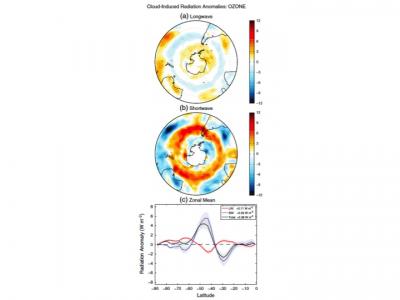Global Warming Caused by the Ozone Hole "Indirect Effect"
Clouds cool the planet by reflecting sunlight to space, but the amount of sunlight that clouds reflect can only be as large as the amount illuminating the clouds. Since the amount of sunlight that the planet receives decreases towards the poles, a shift of cloud cover from low latitudes to high latitudes can cause the planet to absorb more sunlight. It turns out that the Antarctic ozone hole causes the Southern Hemisphere (SH) jet stream and storm track to shift poleward. Thus it is natural to ask whether and to what extent the abundant cloudiness that characterizes the SH mid-latitudes also shifts poleward, and how large of an impact these cloud changes have on the planet's energy budget.
The researchers performed climate model simulations with a stratospheric ozone hole, and found that -- compared to the control simulation -- the mid-latitude jet stream shifted poleward during the SH summer months (DJF). Using the ISCCP simulator, a special tool for diagnosing the cloud fields in the models in a manner similar to satellites, the researchers found that (1) high-level and midlevel clouds closely follow the poleward shift in the SH midlatitude jet and that (2) low-level clouds decrease across most of the Southern Ocean. To quantify how these cloud responses impact the radiation budget of the planet, the authors used cloud radiative kernels, which quantify the impact of cloud anomalies on top-of-atmosphere radiation fluxes. This radiative response is termed the ozone hole "indirect effect" to distinguish it from its direct radiative effect (a small cooling).
The authors find that the cloud anomalies associated with the Antarctic ozone hole cause +0.25 W m-2 of heating, averaged over the SH annually. It arises largely from the reduction of the total cloud fraction at SH midlatitudes during austral summer. During the season in which the effect is largest (DJF), the heating is +0.36 W m-2. This ozone hole "indirect effect" represents a substantial heating that overwhelms the -0.05 W m-2 “direct” effect of thinning ozone layer on the planet’s energy balance. The indirect effect may therefore have been a substantial and important contributor to global warming during the emergence of the ozone hole.
The Antarctic ozone hole causes clouds to shift poleward, and this results in less sunlight to be reflected away from the planet. In climate model simulations, this ozone hole "indirect effect" causes 0.25 Wm-2 of annually averaged heating in the Southern Hemisphere, and overwhelms the direct radiative effect of the ozone hole. The indirect effect may therefore have been a substantial and important contributor to global warming during the emergence of the ozone hole.
K.M.G. and L.M.P. were supported by a National Science Foundation grant to Columbia University. M.D.Z.'s contribution was performed under the auspices of U.S. Department of Energy (DOE) under contract DE-AC52-07NA27344 and was supported by the Regional and Global Climate Modeling program of the U.S. DOE's Office of Science.

